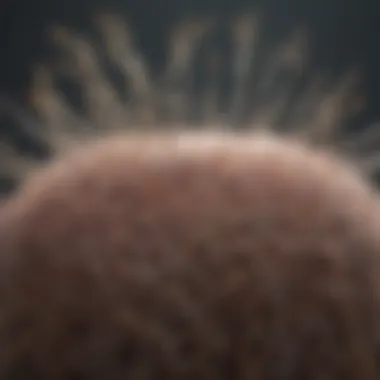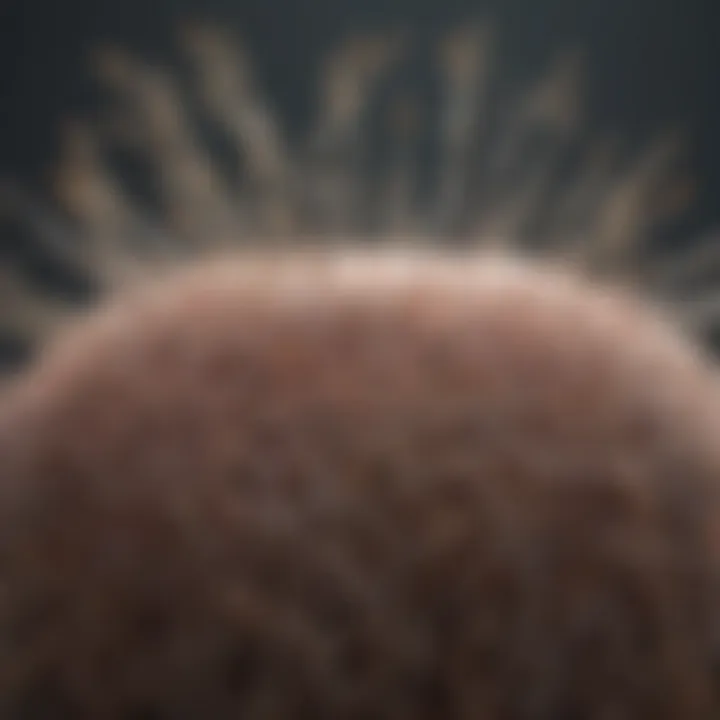Understanding Scalp and Hair Growth Dynamics


Intro
Understanding the relationship between scalp health and hair growth is pivotal for anyone interested in the science of hair. The scalp serves not only as the foundation for hair growth but also influences the overall health and vitality of hair strands. This exploration focuses on unraveling the complex mechanisms that govern hair growth, alongside the various factors that can positively or negatively affect this crucial process.
Research into scalp and hair dynamics reveals an intricate interplay between biological systems, environmental influences, and personal care practices. It highlights the importance of a healthy scalp as an environment conducive to optimal hair growth. To properly appreciate these nuances, it becomes essential to delve into both the anatomical and physiological aspects pertaining to the scalp and the hair follicles it hosts.
In the following sections, we will provide a detailed examination of available literature, grounding our insights in established scientific research and contemporary methodologies. This approach will empower scholars and industry professionals with a nuanced understanding of hair growth mechanics and promote informed decision-making regarding hair care disciplines.
Prolusion to Scalp and Hair Growth
The interconnected nature of scalp health and hair growth plays a vital role in overall hair vitality. When addressing the topic of scalp and hair growth, one must consider multiple aspects: the biological mechanisms at play, the anatomy involved, and the external factors that influence growth cycles. Understanding these relationships not only helps in the maintenance of healthy hair but also aids individuals in making informed decisions regarding hair treatments and care practices.
The Importance of Scalp Health
Scalp health cannot be overstated. A conducive environment for hair follicles is essential, and the scalp provides that foundation. Healthy scalp skin is rich in antioxidants and has an ideal pH level, allowing for optimal hair growth. When the scalp is compromised by conditions such as dandruff or dermatitis, the hair follicles may be adversely affected. This can lead to weak hair, slow growth, or even hair loss.
Regular cleansing and moisturizing of the scalp promote blood circulation. Good blood circulation delivers vital nutrients and oxygen to hair follicles, thus fostering growth. Moreover, scalp health impacts not only hair growth but also hair texture and appearance. A clean, nourished scalp supports strong, vibrant hair that reflects overall well-being. Therefore, taking care of the scalp should be a priority in any hair care regime.
Overview of Hair Growth Mechanisms
To grasp how hair growth occurs, one must understand its underlying mechanisms. Hair grows in cycles characterized by three main phases: anagen, catagen, and telogen. Each of these phases plays a specific role in hair production.
- Anagen Phase: This phase is where actively growing hair is formed. It can last for several years, and during this time, hair can grow about half an inch per month.
- Catagen Phase: Also known as the transitional phase, it lasts for a few weeks. Hair stops growing and begins to break down.
- Telogen Phase: This phase involves the shedding of hair, preparing the scalp for new growth.
Additionally, various biological agents, including hormones and nutrients, significantly affect these phases. Hormones like dihydrotestosterone (DHT) influence how long hair remains in the anagen phase, while deficiencies in nutrients can lead to shortened phases, resulting in thinning hair. Understanding these mechanisms empowers individuals to seek treatments or lifestyle changes that can better support healthy hair growth.
Hair growth is a complex interplay of biological factors, and recognizing these can aid in developing effective care strategies.
Anatomy of the Scalp
Understanding the anatomy of the scalp is vital for comprehending how hair growth functions. The scalp is not just a cover for the skull; it's a complex structure with important roles in both health and hair lifecycle. By elaborating on the components of the scalp, we can better appreciate how they interact to facilitate optimal hair growth and maintain scalp health.
Skin Layers and Their Role
The skin of the scalp serves as the first line of defense for underlying structures. It consists of several layers which each serve distinct purposes:
- Epidermis: The outermost layer, responsible for protecting against environmental factors. It plays a significant role in hydration and overall scalp health. A healthy epidermis allows the scalp to retain moisture, preventing dryness that can lead to hair damage.
- Dermis: Below the epidermis lies the dermis, which contains essential structures such as hair follicles, sebaceous glands, and blood vessels. The dermis provides the necessary conditions for hair growth by supplying nutrients and removing waste.
- Hypodermis: The deepest layer, comprising fat and connective tissues, offers insulation and support to the scalp. It helps cushion the scalp and protects it from external trauma.
Each layer contributes to the overall well-being of the scalp. When these layers function properly, they support healthy hair growth. If any layer is compromised, it can lead to various scalp issues, negatively affecting hair development.
Hair Follicle Structure
The hair follicle is a dynamic structure and is crucial for hair growth. Understanding its anatomy is essential:
- Follicle Bulb: This is typically found deep within the scalp and is the site of hair production. It is where keratinocytes multiply and mature to form hair strands.
- Dermal Papilla: Located at the base of the follicle, it contains blood vessels that supply nutrients essential for hair growth. This structure plays a crucial role in signaling to the follicle when to grow hair.
- Outer Root Sheath and Inner Root Sheath: These protective layers surround the hair and contribute to the formation of the hair itself as it grows upwards toward the surface.
Proper nourishment and signaling from the dermal papilla are vital for healthy hair growth. Any disruption in this structure can lead to hair loss or thinning, underscoring the importance of follicular health in relation to overall hair vitality.
Blood Supply to the Scalp
Blood supply is another critical element in scalp health. The scalp is richly vascularized, providing necessary nutrients and oxygen to hair follicles. The primary blood vessels include:
- External Carotid Artery: This artery branches into several smaller arteries that deliver oxygenated blood to the scalp.
- Superficial Temporal Artery: A branch of the external carotid artery, its branches supply the skin and muscles of the scalp.
- Occipital Artery: Supplies the back of the scalp with essential nutrients.
Maintaining robust circulation in the scalp is necessary. Impaired blood flow can lead to weaker hair follicles and eventual hair loss. Hence, understanding the blood supply helps in recognizing potential causes of hair growth issues.
In summary, a thorough understanding of the scalp's anatomy—its layers, hair follicle structure, and blood supply—enhances our grasp of hair growth and scalp health dynamics. Recognizing these components enables better targeting of treatment options and prevention strategies.


Proper care and attention to the scalp can lead to improved hair quality and growth, making this knowledge essential for anyone invested in hair health.
Phases of Hair Growth
Understanding the phases of hair growth is essential to comprehending the broader dynamics of hair health and maintenance. Each phase is characterized by distinct processes that ultimately shape the lifespan and quality of hair. Grasping these phases enables individuals to make informed choices about hair care practices and potential interventions. Let's explore the three primary phases: Anagen, Catagen, and Telogen.
Anagen Phase
The Anagen phase is the active growth phase of hair follicles. During this time, hair cells proliferate rapidly, resulting in hair growth. This phase can last from two to seven years, depending on individual genetic factors and overall health. Hair in the Anagen phase is typically in the best condition, being usually longer and stronger.
Key notes about the Anagen phase include:
- Duration: The length of this phase varies significantly among individuals, which contributes to the differences in hair length.
- Hair quality: Good nutrition and scalp health can maximize the effectiveness of this phase, leading to thicker strands.
- Factors affecting growth: Hormones and genetics play a considerable role in determining how long a person remains in this phase.
Catagen Phase
Following the Anagen phase, hair enters the Catagen phase, which is relatively brief, lasting about two to three weeks. This transitional phase signifies the end of the active growth period and prepares hair for shedding. During this time, the hair follicle shrinks considerably, and the lower part is destroyed. As a result, the hair detaches from the blood supply.
Considerations for the Catagen phase include:
- Duration: This phase is short and is essential for the healthy cycle of hair growth.
- Transition: The shift from growth to rest prepares the scalp for the next phase, signifying it is a natural part of hair biology.
- Health effects: Stress or hormonal changes can sometimes lead to prolonged Catagen phases, potentially resulting in thinning hair.
Telogen Phase
The Telogen phase is the resting phase when hair is not actively growing. This phase lasts for about three months. Toward the end of this phase, telogen hairs are expelled from the scalp, making way for new growth. The shedding of hair is a normal part of the hair cycle in this phase. While it may appear alarming to witness hair loss, it is a natural occurrence and not indicative of poor scalp health.
Important aspects of the Telogen phase are:
- Duration: The Telogen phase's length can vary; stressors or health issues may influence this duration, leading to premature shedding.
- Hair loss: It is important to understand that losing some hair is part of the body's normal cycle and does not always signify a problem.
- Monitoring hair health: Keeping track of shedding patterns can provide insights into scalp health and inform potential interventions.
Each of these phases is crucial in the overall lifecycle of hair, and understanding them empowers individuals to implement better hair care practices.
In summary, recognizing the phases of hair growth not only enhances our knowledge of hair biology but also guides prevention and treatment strategies for maintaining optimal scalp health.
Factors Affecting Hair Growth
Understanding the factors that influence hair growth is crucial for promoting healthier hair and addressing common hair-related problems. Hair growth is not determined by a single factor but rather a combination of genetic, hormonal, nutritional, and environmental influences. Each of these aspects plays a significant role in the way hair develops, flourishes, or faces challenges. Recognizing these factors allows individuals to take informed steps towards enhancing their scalp and hair health.
Genetic Influences
Genetics is perhaps the most significant factor in hair growth. Genes dictate various characteristics that influence hair density, texture, and rate of growth. People may inherit conditions such as androgenetic alopecia, commonly known as male or female pattern baldness. This condition can lead to hair thinning and loss, typically due to a sensitivity to dihydrotestosterone (DHT), a derivative of testosterone. Genetic predisposition can also affect the number of hair follicles available for growth, impacting overall hair volume.
Hormonal Factors
Hormonal changes are also a vital aspect of hair growth dynamics. Hormones such as androgens, testosterone, and estrogen can influence hair follicles. For instance, during puberty, pregnancy, or menopause, fluctuations in hormone levels can lead to changes in hair growth patterns. High levels of androgens can shrink hair follicles and shorten the anagen phase, resulting in reduced hair growth and increased shedding. Conditions such as polycystic ovary syndrome (PCOS) are another example of how hormonal imbalances can affect hair health negatively.
Nutritional Factors
Nutrition plays a fundamental role in supporting healthy hair growth. A diet lacking essential nutrients can lead to hair weakness and loss. Proteins, vitamins, and minerals are critical for maintaining the integrity and function of hair follicles. Key nutrients include:
- Protein: Hair is largely composed of a protein called keratin.
- Vitamins: B vitamins, particularly biotin, are known for their role in hair health.
- Minerals: Zinc and iron are crucial for proper hair follicle function.
Ensuring a balanced diet filled with these nutrients can enhance hair vitality and promote better growth.
Environmental Influences
Lastly, environmental factors significantly affect hair growth. Causes such as pollution, climate, and exposure to harmful substances can lead to scalp irritation and hair damage. Pollutants can obstruct hair follicle function, leading to potential hair health issues. Additionally, UV radiation can degrade keratin in the hair, weakening it over time. Moreover, lifestyle choices such as smoking and stress can also negatively impact hair growth. Emphasizing protective care and responsible lifestyle choices helps mitigate these environmental risks.
Common Scalp Conditions


Understanding common scalp conditions is essential for both promoting hair health and addressing issues that may arise during the hair growth process. These conditions not only affect the appearance of hair but also can influence its growth and overall condition. Hence, knowledge about them enables effective intervention and the application of suitable treatments. Addressing these issues is important because they often indicate underlying health problems, allergens, or lifestyle factors.
Dandruff and Seborrheic Dermatitis
Dandruff is one of the most prevalent scalp conditions, characterized by flaking and itching. It occurs due to an imbalance in the scalp's natural microbiome, often exacerbated by the Malassezia yeast. This results in excess skin cell production and shedding. Seborrheic dermatitis is a more severe form, leading to red, greasy patches that can cover larger areas of the scalp.
The treatments range from over-the-counter shampoos containing zinc pyrithione or ketoconazole to prescription medications. Maintaining a balanced diet and managing stress levels can further help mitigate symptoms. It's crucial to recognize that both conditions can be chronic and may require long-term management.
Psoriasis
Psoriasis on the scalp presents as red patches covered by thick, silvery scales. This autoimmune condition arises when the immune system mistakenly accelerates skin cell production. Psoriasis is often painful and can lead to severe itching. Most individuals with scalp psoriasis also experience lesions on other body parts.
Treatment involves topical steroids, vitamin D analogues, and in some cases, systemic medications. Regularly moisturizing the scalp is also beneficial. Understanding this condition is vital for providing appropriate care and reducing discomfort.
Alopecia Areata and Other Types
Alopecia areata is an autoimmune disorder that causes hair loss, typically in patches. Though it can affect hair on any part of the body, its connection to stress and genetic factors makes it particularly concerning. The condition can manifest as complete scalp hair loss, known as alopecia totalis, or total loss of body hair, termed alopecia universalis.
There are various treatments including corticosteroid injections and topical treatments. The success of these treatments varies among individuals, and a comprehensive approach is often necessary, tailored to the specific type and severity of hair loss experienced. Additionally, there are other forms of hair loss that share similar traits, and educating oneself on these distinctions can aid in understanding potential treatments and outcomes.
"A thoughtful examination of common scalp conditions lays the groundwork for a more comprehensive understanding of skin health and hair viability."
By understanding these common conditions, individuals can be proactive in their approach to scalp health, ultimately leading to healthier hair growth. This focus on specific scalp conditions creates opportunities for both self-care and professional interventions, enhancing the quality of life for those affected.
Effective Treatments for Hair Growth
Effective treatments for hair growth play a crucial role in maintaining not just the aesthetics of one’s appearance but also the overall health of the scalp. This section dives into various avenues available for enhancing hair growth, with a focus on topical treatments, oral medications, supplements, and surgical interventions. Each treatment category presents unique benefits and considerations that can help an individual achieve healthier, more vibrant hair. The selection of appropriate treatment often hinges on the specific scalp condition, personal health factors, and desired outcomes.
Topical Treatments and Their Efficacy
Topical treatments are among the most widely used options for addressing hair loss and promoting growth. Common topical products include minoxidil, a well-known vasodilator that enhances blood flow to hair follicles, stimulating growth. Research indicates that, when applied consistently, minoxidil can lead to significant improvements in hair density.
- Minoxidil: This treatment is available over the counter in various formulations, including liquid and foam. Users generally see results after four to six months of regular application. However, discontinuation can lead to hair loss reverting to baseline levels.
- Natural Oils: Oils such as rosemary and castor oil are gaining popularity in home remedies. While scientific evidence supporting their efficacy is limited, many users report positive experiences with improved hair condition through regular scalp massages.
- Shampoos with Active Ingredients: Some shampoos are formulated with ingredients like biotin, ketoconazole, and saw palmetto. These components are believed to strengthen hair and combat shedding.
Effective topical treatments can restore not only hair but also confidence. Consistency is key for achieving desired results.
Oral Medications and Supplements
Oral medications and supplements can provide additional support for hair growth. Unlike topical treatments, these options aim to address internal factors influencing hair health.
- Finasteride: This prescription medication is primarily used in men for androgenetic alopecia. It works by inhibiting the conversion of testosterone to dihydrotestosterone (DHT), a hormone linked to hair loss. Users can experience notable regrowth, but potential side effects may include a decrease in libido and other hormonal imbalances.
- Biotin and Other Vitamins: Nutritional supplements, including biotin, Vitamin D, and iron, are often recommended for improved hair health. While more research is necessary to establish their effectiveness conclusively, they are part of a balanced approach.
- Omega-3 Fatty Acids: Found in fish oil and flaxseeds, these fatty acids may help promote scalp health and support hair growth, thus combating dryness and inflammation.
Surgical Interventions
Surgical options may be recommended for those who do not respond to other treatments or have more severe hair loss. These interventions can be quite effective for restoring hair, though they are often costly and may involve considerable recovery time.
- Hair Transplant Surgery: This procedure involves relocating hair follicles from a donor site, typically the back of the head, to balding areas. Follicular unit extraction (FUE) is a popular method due to its minimally invasive nature and quicker recovery time.
- Scalp Reduction: In some cases, areas of bald scalp can be surgically removed and the hair-bearing scalp can be pulled together. This approach can be effective but is less common today due to advancements in hair transplantation.
Prevention Strategies for Scalp and Hair Health
Effective prevention strategies for scalp and hair health are essential for maintaining healthy hair growth. These strategies focus on proactive measures that can minimize hair loss and support overall scalp vitality. Prioritizing prevention allows individuals to address potential issues before they escalate. This section will discuss key elements such as diet, hair care practices, and avoiding harmful chemicals, offering insights into how these factors contribute to optimal scalp and hair conditions.
Maintaining a Healthy Diet
A balanced diet is foundational for healthy hair and scalp. Nutrient-rich foods promote blood circulation and support hair follicle health. Key nutrients include:
- Proteins: Hair is primarily made of protein, particularly keratin. Including lean meats, fish, beans, and legumes can supply the necessary building blocks for hair growth.
- Vitamins: Vitamins such as A, C, D, and E, along with the B-vitamins like biotin, support scalp health and hair strength. Leafy greens, fruits, and nuts are excellent sources.
- Minerals: Zinc and iron play roles in hair tissue growth and repair. Foods like seafood, spinach, and seeds can help provide these vital minerals.
In summary, a diet rich in essential nutrients is crucial. Consideration of these dietary elements can make a significant impact on hair growth and scalp health over time.


Hair Care Practices
Proper hair care practices help minimize breakage and maintain scalp health. Regular washing and conditioning are vital; dirt and oil accumulation can hinder hair growth. It is recommended to use a gentle shampoo suited for your hair type. Additionally, consider the following practices:
- Avoid excessive heat: Minimize the use of hair dryers or straighteners.
- Gentle brushing: Use a wide-toothed comb to reduce breakage.
- Scalp massages: Stimulate blood flow by massaging the scalp during washing or application of oils.
Incorporating these practices fosters a healthier environment for hair to grow while protecting the scalp from potential damage.
Avoiding Harmful Chemicals
Exposure to harmful chemicals can have detrimental effects on scalp and hair health. Many commercial hair products contain sulfates, parabens, and heavy fragrances that may irritate the scalp or cause hair to weaken. Thus, it is advisable to:
- Choose sulfate-free shampoos: These are gentler and less likely to strip natural oils.
- Read labels carefully: Understand the ingredients in your products. Avoid those known to cause irritation, such as certain alcohols and synthetic additives.
- Consider natural alternatives: Use natural oils like coconut or argan oil for conditioning instead of chemical-heavy products.
By being vigilant about the products used on the hair and scalp, one can significantly reduce the risk of adverse reactions and promote a healthier scalp environment.
"Preventive care can be more effective than reactive treatments when it comes to scalp and hair health."
Current Research Trends in Hair Growth
The field of hair growth research is rapidly evolving, driven by technological advancements and growing interest in scalp health. This section highlights the pressing importance of current research trends in understanding hair growth mechanisms. By exploring methods like stem cell therapy and genetic engineering, we can gain insight into innovative approaches to hair restoration and overall scalp health.
Stem Cell Therapy and its Applications
Stem cell therapy represents a cutting-edge development in hair growth treatments. This approach utilizes the regenerative capacity of stem cells to promote hair follicle development and function. Researchers are investigating how these cells can be harvested from various sources, including adipose tissue and the scalp itself.
The key benefits of stem cell therapy include:
- Regeneration of Hair Follicles: Stem cells may stimulate dormant follicles, leading to new hair growth.
- Natural Hair Restoration: Utilizing the body’s own cells could reduce risks of rejection and side effects.
- Customization of Treatments: Individualized therapy based on the patient's specific biology and needs.
Current studies are focusing on the methodologies for transplantation and the effectiveness of various growth factors. Understanding how these stem cells interact with scalp tissue is vital for developing successful treatment protocols.
"Stem cell therapy offers a promising horizon for those experiencing hair loss, but thorough research is required to confirm its efficacy in diverse populations."
Genetic Research and Engineering
Genetic research is another pivotal trend in hair growth studies. The exploration of how genetic factors influence hair growth can lead to targeted therapies that address specific forms of hair loss. A recent focus has been on identifying key genetic markers linked to alopecia and other conditions.
Some essential considerations in genetic research include:
- Gene Editing Techniques: Tools like CRISPR-Cas9 allow for precise modifications at the genetic level, potentially reversing hair loss causatives.
- Understanding Hair Growth Genes: Discovering how genes regulate hair cycling phases can lead to novel treatment strategies.
- Ethical Considerations: As research delves deeper into genetic engineering, ethical considerations must be addressed regarding the implications of altering genetic materials.
This branch of research could lead to breakthroughs that not only enhance hair growth but also address underlying genetic predispositions, offering a comprehensive solution to hair loss.
Ending
In this article, we have explored the various facets of scalp and hair growth, emphasizing the significance of understanding this intricate relationship. The conclusion not only summarizes the key elements discussed throughout but also highlights the benefits and the important considerations relevant to scalp and hair health. An informed approach is essential for both individuals and professionals in the field.
Firstly, maintaining healthy scalp conditions is fundamental for optimal hair growth. The complex interplay between scalp health and hair follicle function cannot be understated; conditions such as dandruff and psoriasis often lead to disrupted growth patterns. Understanding these conditions can guide effective treatments and care strategies for individuals experiencing hair loss or other scalp issues.
Additionally, we reviewed the multiple factors influencing hair growth, from genetic predispositions to nutritional intake and environmental impacts. Recognizing these influences allows individuals to make informed choices regarding their hair care routines and overall health.
"Scalp health is crucial for hair growth. Ignoring it can lead to various issues, potentially affecting self-esteem and overall quality of life."
Finally, we discussed key preventive measures and effective treatment options available today, which are essential for maintaining a thriving scalp environment and encouraging healthy hair. Professionals in the field should prioritize ongoing education and research to remain abreast of emerging trends in hair growth technologies and therapies.
Summary of Key Points
- Importance of Scalp Health: Healthy scalp is vital for hair growth; conditions like dandruff can hinder success.
- Factors Affecting Growth: Genetic, hormonal, nutritional, and environmental factors play pivotal roles in hair health.
- Effective Treatments: Both topical and oral medications can aid in promoting hair growth and improving scalp conditions.
- Preventive Strategies: A balanced diet, healthy hair care practices, and the avoidance of harmful chemicals are crucial for optimal scalp and hair health.
Future Directions in Scalp and Hair Research
Looking ahead, the future of scalp and hair research appears promising, with several exciting trends emerging.
- Stem Cell Therapy: Continued research into stem cell applications holds the potential to revolutionize treatments for hair loss. By utilizing stem cells, researchers aim to stimulate the regeneration of hair follicles.
- Genetic Engineering: Advances in genetic research may provide insights into hereditary hair loss, allowing for targeted therapies that address the genetic factors contributing to this condition.
- Customized Treatments: Personalized medicine is expected to play a significant role, permitting tailored approaches based on individual genetic makeup and specific scalp conditions.
- Innovative Technologies: The integration of technology, such as artificial intelligence and 3D biomodels, will likely enhance our understanding of hair growth dynamics and therapeutic responses.



